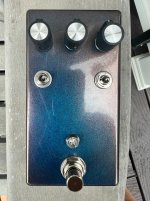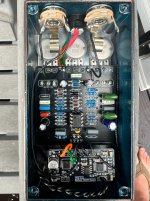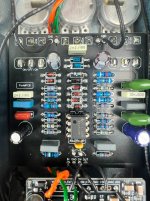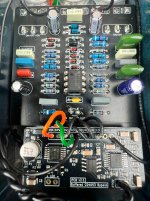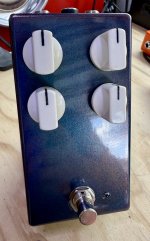- Build Rating
- 4.00 star(s)
Here's my build of the Stagecoach Overdrive, based on the Barber BUSS fww Edition.
I'm not even sure what prompted me to buy this. And I probably would have sat on it, except that, several weeks ago, I drilled the enclosure for it. I drilled the enclosure thinking I had already populated the board. So when I got some time yesterday, I thought I could finally finish it up. I think I spent well over an hour, gaining in frustration the whole time, trying to find the populated board. That search included me going through my pile of unpopulated boards numerous times... and the Stagecoach board was in fact not populated. This is/was a brain fart of seismic proportions, or maybe a series of brain farts. I was absolutely certain that I had populated the board!
But, whatever. I went ahead and built it up yesterday, and finished this morning. I did a quick sanity test after I finished it: happy to say it worked great on first power-on. It was somewhat early in the morning, and I didn't want to disturb the family, and so my test was pretty quiet. I thought it sounded OK, but not good enough to knock my current favorite off my board.
But then I went back and tested it again, this time a bit louder. Not at loud volume by any means - just a bit above conversational volume (whereas the initial test was whisper-in-the-library quiet). And wow! I'm impressed!
I've built a couple Barber pedals in the past: the Candid Drive (Direct Drive), and the Gain Changer. Both of those were great, just didn't have the particular indescribable (and admittedly ephemeral) "magic" I was looking for. So they are long since sold.
I need more play time on the Stagecoach, but so far, it might be a keeper. If I continue to be as impressed as I am now, I'll likely give it the custom PCB treatment, with some kind of integrated bypass scheme. But I'm getting ahead of myself.
It seems to be more EQ-neutral ("transparent") than I remember the Gain Changer and Direct Drive being. But it's been a minute since I played those, so take that comment with a grain of salt.
One thing I've always liked about Barber designs - besides the great tone - is the "user interface". That is, three knobs where the 11:00 to 1:00 position (for all knobs) is just about perfect, and switches that allow you to tweak the tone and/or character of the effect. I find this to be a particularly compelling blend of simplicity and flexibility.
The build itself was unremarkable. The enclosure is the Alexandrite 125B from @StompBoxParts. It's a really neat finish - the color kind of shifts depending on how the light hits it. Perfect for pedals with an "obvious" control scheme (where you can get away without labels, aka @MichaelW school of pedal art). Unfortunately, as you can see in the pic, I managed to put a couple significant scratches right in the front when I was drilling it. I guess I can call it "relic".
The actual effect I assembled from parts I had on hand, all garden-variety stuff. I did use BAT41 diodes instead of germanium, but otherwise, built exactly per the PCB silkscreen.
The smaller PCB at the bottom is my buffered electrical bypass module.
All-in-all, a surprising success that I didn't expect!
I'm knocking a star from my self-rating for the nasty scratches I accidentally put on the enclosure.
I'm not even sure what prompted me to buy this. And I probably would have sat on it, except that, several weeks ago, I drilled the enclosure for it. I drilled the enclosure thinking I had already populated the board. So when I got some time yesterday, I thought I could finally finish it up. I think I spent well over an hour, gaining in frustration the whole time, trying to find the populated board. That search included me going through my pile of unpopulated boards numerous times... and the Stagecoach board was in fact not populated. This is/was a brain fart of seismic proportions, or maybe a series of brain farts. I was absolutely certain that I had populated the board!
But, whatever. I went ahead and built it up yesterday, and finished this morning. I did a quick sanity test after I finished it: happy to say it worked great on first power-on. It was somewhat early in the morning, and I didn't want to disturb the family, and so my test was pretty quiet. I thought it sounded OK, but not good enough to knock my current favorite off my board.
But then I went back and tested it again, this time a bit louder. Not at loud volume by any means - just a bit above conversational volume (whereas the initial test was whisper-in-the-library quiet). And wow! I'm impressed!
I've built a couple Barber pedals in the past: the Candid Drive (Direct Drive), and the Gain Changer. Both of those were great, just didn't have the particular indescribable (and admittedly ephemeral) "magic" I was looking for. So they are long since sold.
I need more play time on the Stagecoach, but so far, it might be a keeper. If I continue to be as impressed as I am now, I'll likely give it the custom PCB treatment, with some kind of integrated bypass scheme. But I'm getting ahead of myself.
It seems to be more EQ-neutral ("transparent") than I remember the Gain Changer and Direct Drive being. But it's been a minute since I played those, so take that comment with a grain of salt.
One thing I've always liked about Barber designs - besides the great tone - is the "user interface". That is, three knobs where the 11:00 to 1:00 position (for all knobs) is just about perfect, and switches that allow you to tweak the tone and/or character of the effect. I find this to be a particularly compelling blend of simplicity and flexibility.
The build itself was unremarkable. The enclosure is the Alexandrite 125B from @StompBoxParts. It's a really neat finish - the color kind of shifts depending on how the light hits it. Perfect for pedals with an "obvious" control scheme (where you can get away without labels, aka @MichaelW school of pedal art). Unfortunately, as you can see in the pic, I managed to put a couple significant scratches right in the front when I was drilling it. I guess I can call it "relic".
The actual effect I assembled from parts I had on hand, all garden-variety stuff. I did use BAT41 diodes instead of germanium, but otherwise, built exactly per the PCB silkscreen.
The smaller PCB at the bottom is my buffered electrical bypass module.
All-in-all, a surprising success that I didn't expect!
I'm knocking a star from my self-rating for the nasty scratches I accidentally put on the enclosure.

